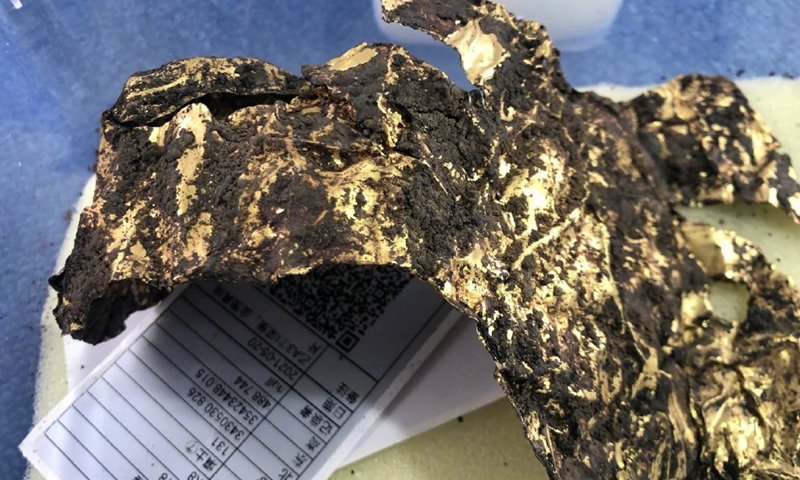Deemed one of China’s most famous archaeological discoveries in the world, the Sanxingdui Ruins site in Southwest China’s Sichuan Province on Friday revealed a newly unearthed artifact: a 3,000-year-old gold mask.
A total of 534 important cultural relics including ivory, bronze, gold, jade ware and nearly 2,000 pieces of broken cultural relics have been unearthed from six sacrificial pits of the Sanxingdui Ruins as of late May, and the latest gold mask was discovered at the eighth pit.
Officials revealed the latest achievements of the Sanxingdui archaeological excavation at a global promotion event in the Sanxingdui Museum on Friday.

As of late May, more than 1,000 important cultural relics have been unearthed at the Sanxingdui Ruins, and a newly discovered golden mask is under restoration, officials said at a global promotion event on Friday. Photo:CCTV
“The newly discovered gold mask is still being restored, and it is unknown when it will be ready to be shown to the public,” said Tang Fei, dean of the Sichuan Provincial Cultural Relics and Archeology Research Institute.
Tang told the Global Times that the archaeological team has almost finished its work to extract all the ivory relics from the site, and is carrying out further research, including the DNA of ivory relics.
“As the bronze-made relics are buried under the ivory relics, the next stage for us is to excavate the bronze ware. But it is still unknown how long that will take as it depends on the integrity of the relics,” said Tang, adding that they could extract four to five relics per day if the relics are complete, while one fragile or incomplete bronze relic might take two to three days.
“The latest achievement at the Sanxingdui Ruins site is we have confirmed that the silk relics were used in sacrificial offerings in the ancient dynasty,” Tang said.
Organized by the State Council Information Office, the National Cultural Heritage Administration and the Sichuan Provincial People’s Government, the global promotion event for the Sanxingdui Ruins also aims to introduce the great culture to the world to enhance exchanges and learning between Chinese and other civilizations.
“Sanxingdui Ruins will become an international tourism site after the completion of the Sanxingdui Ruins Park, and we are preparing to apply it as a world cultural heritage site with the Jinsha site in Chengdu, Sichuan Province,” said Luo Qiang, vice-governor of Sichuan Province.
According to Zhu Yarong, deputy curator of the Sanxingdui Museum, exhibits from Sanxingdui Ruins have been held in 21 countries, covering five continents. But during the post-COVID-19 era, the exhibits of the current discoveries will be mainly held in digital form.
Compared with Troy
First discovered in 1929, the Sanxingdui Ruins site, which dates back to the Bronze Age over 3,000 years ago, has been the source of one pleasant surprise after another following decades of digging and archaeological research. It is the largest and highest-ranking centralized site ever found in the Sichuan Basin, and is believed to date back to the Xia (c.2,070 BC-c.1,600 BC) and Shang (c.1,600 BC-1,046 BC) dynasties.
In March, Chinese archaeologists unearthed more than 500 relics in six ancient sacrificial pits, stunning archaeologists and history buffs in China and the rest of the world. The cultural relics included a mysterious bronze mask, a more than 2-meter-tall bronze statue, and a mask made of gold, giving modern people a peak into the ancient cultures that existed in the upper reaches of the Yangtze River.
Huo Wei, dean of the School of Archaeology, Culture and Museum at Sichuan University and curator of the Sichuan University Museum, told the Global Times on Friday that the archaeological discoveries of Sanxingdui Ruins will become one of the most famous archaeological discoveries in the world.
“The academic value of the Sanxingdui Ruins site to the history of Chinese bronze culture can be compared with the value of the Troy and Nineveh site, which has great significance to the origins of early European civilization,” said Huo.
According to Huo, the Sanxingdui civilization has a unique contribution to the origin and formation of Chinese civilization. For example, the 112 bronze wares that were excavated from the two sacrificial pits in 1986 showed that people living in the ancient kingdom of Shu not only made some similar artifacts that imitated the bronzes of the Central Plains area of China, but also had another hierarchy and worshiping system which can be seen in their relics including a gold mask, bronze standing figure and bronze tree that are totally different with those from the Central Plains area of China.
“The discovery of the Sanxingdui Ruins site has greatly enriched the cultural connotation of the origin and formation of Chinese civilization. For the first time, people realize that besides the ritual system represented by the rigorous and standardized bronze wares in the Central Plains area of China, there were also some alternative ways, similar to the Bronze Age of Eurasia, in expressing people’s worship and beliefs,” said Huo.
He said the Sanxingdui civilization was likely based on the traditional Central Plains civilization and the prominent Bashu culture, and it also extensively absorbed certain factors from other ancient civilizations around it. It had the characteristics of the integration of Eastern and Western civilizations.
From a geographical perspective, the Sanxingdui civilization was located in the so-called “Huaxia Fringe” zone. It had a fixed transportation route with the ancient Silk Road to the northwest, and the road in its south led directly to South Asia, Southeast Asia, and all parts of the coast of China. It even had contact and connections with the Qinghai-Tibet Plateau as early as the prehistoric Neolithic period.
“The openness and tolerance of the ancient kingdom of Shu with the outside world provided the Sanxingdui civilization with a lavish cultural environment,” Huo said.
Sanxingdui Photo: CCTV


